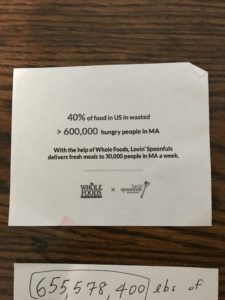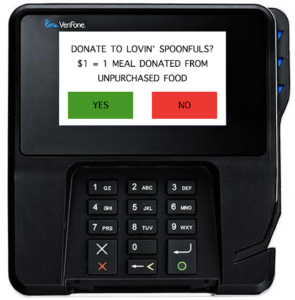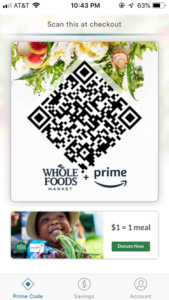Lily Xie, Berlynn Bai, Nora Wu
In our project, we partnered with Lovin’ Spoonfuls, a food rescue organization based in Brookline, in order to reach and educate new donors. In a previous project for the class, we imagined ourselves as representatives from Lovin’ Spoonfuls to create a food waste map game for high schoolers; this time, we wanted to work more directly with the organization to target an audience and goal that was meaningful and impactful in real life. We were able to interview the marketing director at Lovin’ Spoonfuls about the challenges the organization faced and the most impactful data stories that still needed to be told.
Based on our interview, the goals of our data story are the following:
- To educate the communities in Cambridge about food insecurity, food waste and food rescue
- To promote the work and impact of Lovin Spoonfuls
- To encourage donation and behavioral change from our targeted audience
Our targeted audience is anyone who shops at Whole Foods. We chose consumers of grocery stores as our targeted audience because we believe they have purchasing power to fulfill the need of Lovin Spoonfuls. Lovin Spoonfuls operates under the impact model of “People. Profits. Planet” – by supporting Lovin Spoonfuls, individuals are supporting the health of food insecure individuals, making a positive impact to the environment, and (for donors) making a non-taxable donation. Lovin Spoonfuls also holds close relationship with retail stores so that the stores can generate profits through Lovin Spoonfuls’ purchases.
Lovin Spoonfuls is not a competitor for any grocery stores, rather, collaborating with Lovin Spoonfuls would help with branding and attract local attention through this partnership. After talking with the Communications & Marketing director at Lovin Spoonfuls, we learned that what Lovin Spoonfuls needs the most is monetary donation. Given the number of Whole Foods in Cambridge and its motto on “Whole Foods, Whole People, Whole Planet” , we believe that consumers of Whole Foods would be a perfect audience for our project.
In order to test out our prototype, we interviewed four individuals at the Whole Foods store on Prospect Street. Our interview questions follow three parts: 1) what is their pre-existing knowledge about food waste, food security and food rescue 2) what are their opinions on our current prototype 3) what are the factors that could lead to their donation (if not the existing prototype).

We learned that most people have a general idea of what food waste is, but haven’t thought about what happens to the wasted food. Instead of highlight the problem, we should help consumers to think about solution that can be done for food waste. In addition, the solution should link to the work of Lovin Spoonfuls – individual solution, such as buying less food, is not optimal in this scenario. We need to communicate that food waste is a systemic issue that cannot be solved by individual austerity, just as one of the interviews said, “I would need to know why what this organization does is better than me just buying less”. Therefore, the message of transforming food waste to food insecurity and lack of access to healthy food is critical in our data story.
People also want to know, before they donate, where is the money going. Therefore, having “$1 = 1 meal” is important to inform the impact of each donation. In addition, we learned that people anchor on numbers but don’t always engage with the text. Having the number more evident, or finding different ways to visualize the number (such as 600 million lbs of food) would be more captivating and provocative for the audience.


